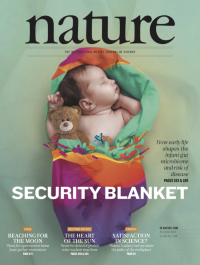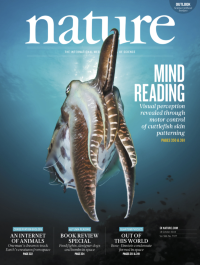Volume 562
-
No. 7728 25 October 2018
Security blanketThe development of the gut microbiome from birth through to childhood is thought to be important for the pathology of diseases such as type 1 diabetes, but much is yet to be learnt about this phase of our microbiome development. Two papers in this issue draw on the most comprehensive data set on the infant microbiome to date to shed fresh light on this transitionary stage. The Environmental Determinants of Diabetes in the Young (TEDDY) study spans six research centres in the United States, Sweden, Germany and Finland. In one paper, Joseph Petrosino and his colleagues use gene sequencing to analyse 12,500 stool samples from 903 infants, collected monthly from the age of 3 to 46 months. They characterize the development of the microbiome in this cohort into three distinct phases, and observe how breastfeeding, among other notable factors, contributes significantly to this process. In a second paper, Curtis Huttenhower and his colleagues analysed nearly 11,000 stool samples from 783 infants in the TEDDY study to characterize the early gut microbiome in type 1 diabetes. They find that microbiomes in infants who do not progress towards type 1 diabetes have more genes related to fermentation and the synthesis of short-chain fatty acids, which is suggestive of a potential protective effect.
Spotlight
-
No. 7727 18 October 2018
Mind readingThe unique ability of cuttlefish, squid and octopuses to hide by imitating the colours and texture of their environment has fascinated natural scientists since the time of Aristotle. Uniquely among all animals, these molluscs control their appearance by the direct action of neurons onto large numbers of expandable pixels called chromatophores located in their skin. In this week’s issue, Gilles Laurent and his colleagues used this neuron–chromatophore correspondence to peer into the brain of cuttlefish, inferring the putative structure of control networks through analysing the dynamics of tens of thousands of chromatophores during naturalistic behaviour over timescales ranging from hundredths of seconds to weeks.
Nature Outlook
-
No. 7726 11 October 2018
National health analysisThe UK Biobank is a prospective cohort study that has collected genetic and phenotypic data from some 500,000 people aged 40–69 from across the United Kingdom. The participants have undergone health measurements, provided blood, urine and saliva samples, given detailed information about themselves and agreed to have their health followed. In this week’s issue, Jonathan Marchini, Peter Donnelly and their colleagues report on the data set for the full cohort, including high-resolution genetic data and demonstration of their use in genetic association studies. In an accompanying paper, Stephen Smith, Jonathan Marchini and colleagues report brain imaging of the first 8,428 UK Biobank participants and the results of genome-wide association studies of 3,144 functional and structural brain-imaging phenotypes. They find that many of the traits are heritable and uncover many regions of the genome linked to these structural and functional measures. All of the data sets and research results from the UK Biobank are available to researchers as an open-access resource.
Spotlight
-
No. 7725 4 October 2018
Science sharedThe cover image shows Remisy (left), an oral historian of the Mikea people, discussing the history of a settlement in the Namonte basin in Madagascar with Tsiazonera (right), a historian at the University of Toliara in Madagascar. Such integrated work is characteristic of the co-production of research, in which the people who will be affected by a study’s outcomes are getting involved in designing and driving the research itself. Such co-production is reshaping the scientific landscape, with stakeholders, scientists and societies working shoulder to shoulder to make a difference. In a special issue, Nature looks at the promise and the pitfalls of research co-production, offering guiding principles, case studies and personal reflections on how this cultural shift can help make science more relevant and useful.
Spotlight




